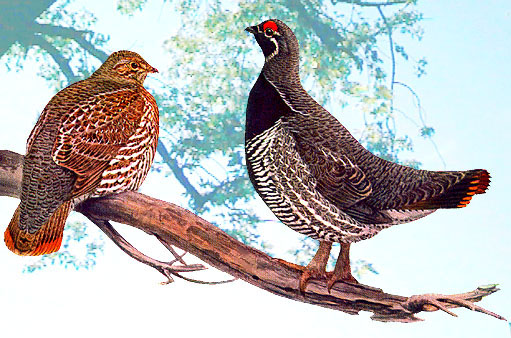
Spruce Grouse (Dendragapus canadensis)
 Female and male
Female and male
|
OTHER NAMES:
Canada Grouse; Black Grouse; Wood Grouse; Wood Partridge; Hudson Spruce Partridge; Spotted Grouse; Cedar Partridge; Swamp Partridge.
|
GENERAL DESCRIPTION:
Length, 17 inches. Males are black and gray above, and black below, variegated with white; females are brown, tawny, and black above, and .dull-whitish below, barred with black. Both sexes are without crests or ruffs; tarsus feathered to the toes; tail with r6 feathers.
|
ADULT MALE:
Plumage of entire upper parts, wavy-barred with black and gray; some rufous markings on back and wings; white markings on shoulders and wing-coverts; lores, whitish; throat and
sides of head below eye, black bordered with broken white; a bright yellow or reddish-colored comb over eye of naked skin; tail, black broadly tipped with orange-brown; under parts, deep glossy black much variegated with white; under tail-coverts tipped with white; sides and breast with white crescented bars.
|
ADULT FEMALE:
Entire upper parts, umber brown varied with tawny and ocher and traversely barred with black; lores and a short streak behind eye together with an obscure patch on side of throat, whitish; beneath, dull whitish much mixed with tawny particularly on breast; nearly everywhere wavy-barred with blackish; shorter in front, more heavily behind; flanks, streaked with white; tail mottled with buff and tipped very narrowly with orange-brown.
|
NEST:
On the ground, well-concealed under low conifer branches, brush heaps, or tamarack; constructed of dry twigs and leaves and lined with moss and grass. |
EGGS:
8 to 14, buffy or reddish-brown, blotched and spotted with different shades of darker brown |
| |
 Distribution: Distribution:
From the eastern base of the Rocky Mountains west of Edmonton, Alberta, east to Labrador Peninsula; also a disconnected area in Alaska from Bristol Bay to Cook Inlet and Prince William Sound. |
The Spruce Grouse is also called the Spruce Partridge in common parlance to distinguish it from the Birch Partridge (Ruffed Grouse). This Grouse has been divided into three races or subspecies, differing slightly in plumage but hardly any in habits. The races are: (I) Hudsonian Spruce Partridge (Canachites canadensis canadensis), (2) Alaska Spruce Partridge (Canachites canadensis osgoodi), and (3) Canada Spruce Partridge (Canachites canadensis canace). These three races (each in its allotted place) inhabit most of the wooded regions of Canada and Alaska except southern British Columbia, Alaska, and central Alberta, where another species, Franklin's Grouse (Canachites franklini), takes their place.
The Spruce Grouse is a bird of the northern wilderness. Only one of the three races of Canadensis ever reaches the United States, and that one, the Canada Spruce Grouse, touches only a few of the northern States, in most of which
it is now nearly or quite extinct. The Spruce Grouse is a dweller in dark spruce woods and tamarack swamps, north into boreal regions, probably as far as its favorite trees extend.
In the mating season the male struts about with bristling feathers, head, neck, and tail raised, tail expanded and body held level. The drumming is not done exactly like that of the Ruffed Grouse, but the bird performs by beating the air with its wings as it climbs up a leaning tree trunk, or else it flies from the ground, sometimes nearly to the tree tops, often only a few feet in air, and drums suspended with beating wings.
In its native wilds this bird exhibits the most charming confidence in mankind. The hunters know it as the champion fool among birds. Full-grown birds have been caught in the hand or beheaded with a switch. The hunter meets a brood in the trail and they merely step aside and watch the passer with a sort of affectionate regard.
In the colder seasons it feeds on spruce and fir foliage and in summer much of its diet consists of insects and berries.
| Upland Ground Birds | Home | Bird Classifications |
|


 Distribution:
Distribution: